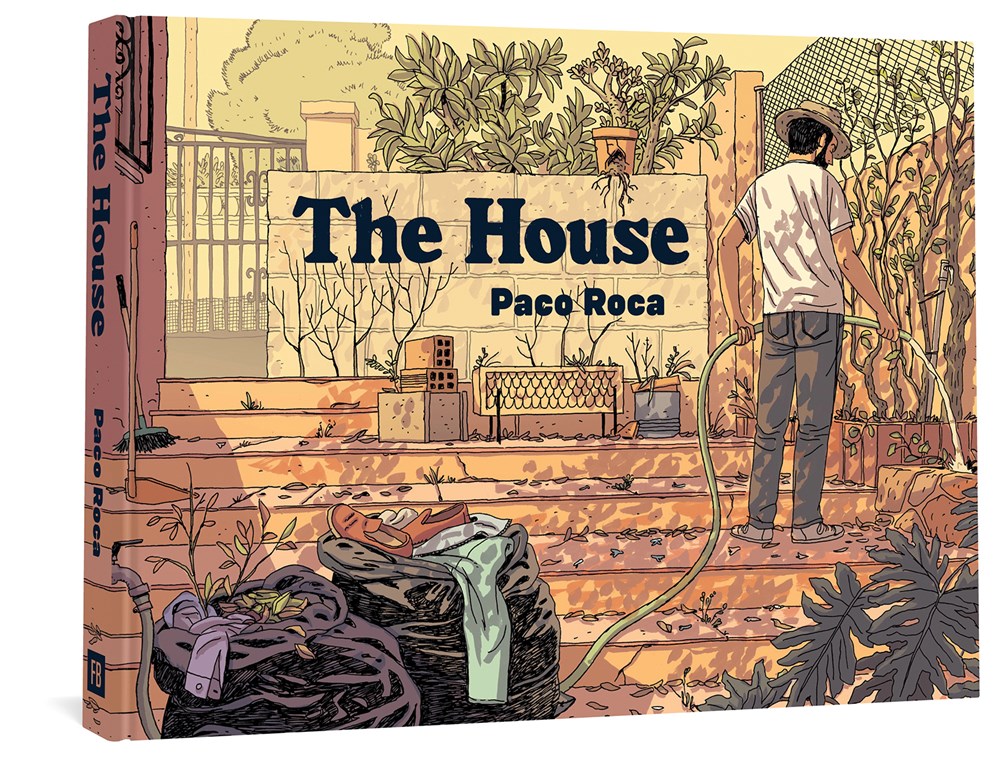
What is home? While the word “home” denotes a structure in which people live, it carries a heavy connotation. A home is more than just a building or place; it is an emotional attachment. “Home” can connote ideas of safety, place, and, ultimately, identity. An empty house is a coffer, waiting for life to exist within its confines so that it can, at last, become a home.
The House by Spanish cartoonist Paco Roca was originally published in 2015 but was re-released with Andrea Rosenberg’s translation last year by Fantagraphics. The book examines this intersection between the ideas of a house and the ideas of a home in a beautifully paced, inventively laid out, rectangle of a book saturated in rich yet muted browns and greens full of tight lines and deep shadows. It is a story about the power of place to transcend time, create bonds, and form families.

The House follows three siblings, Vicente, José, and Carla, who return to their family vacation home a year after their father’s death. As they prepare the structure to be sold, each character relives episodic memories of their childhood in that place. In doing so, they also confront their role and function in its existence, and, most importantly, their understanding of their father. They have come to see the house as an extension of their father, his identity, and his dreams for himself and his family.
The father built the house as a reflection of who he wanted to be. Part of the underclass due to poverty, the father had put his aspirations of place and status into the structure, pulling the entire family into the exercise. His children at the time had little to no appreciation for this, viewing the family vacations there as akin to a work camp rather than any sort of legacy building. It is only in the absence of the father that they begin to understand what the house meant to him. And as they begin to understand the house, so too do they begin to understand the father.
Locations also evoke a certain type of personality memory. As the three siblings join together to fix up their father’s house, old arguments and personality tics come to the forefront. In a way, the three of them revert to the family dynamics that existed when they lived together, tensions that have really never been fully explored or resolved. Coming back to the house allows for a type of healing and understanding that could never be obtained in any other location. The house itself provides the space necessary to confront that which had previously been pushed aside. Paco Roca does an amazing job, specifically in his use of color and layout, of both linking the space with memory, as well as documenting the healing of what is broken in their relationship as the siblings repair what is broken in the house.

In the end, the act of confronting this house leads them to understand its role as their home. In this act, they draw together as a family. In this act, they finally understand their father.
In one of the most poignant sequences in The House, Paco Roca juxtaposes a running hose slowly being turned off with a conversation between the oldest brother, Vicente, and his young sister, Carla, about the day their father died. Vicente, in his role as the one tasked with his father’s care at the end of his life, was alone when the decision came down to either try to resuscitate his truly sick father who had lapsed into a coma, or “sedate him and let him go.” Alone, he had to make that choice and the question of whether it was the right one. The question haunts him as much as the father’s spirit haunts the house they are repairing. If they sell their father’s house, how much more of him do they lose? Again, what is the right choice? What are the ramifications of no longer having a place that they could collectively call home?
For the most part, we live in a highly mobile society. Many families have the luxury of having several different houses to call home in the course of their lifetimes. Likewise, generations leave home to find economic opportunity or to establish their own identity in new places, sometimes a continent away. Those left behind either downsize or are forced to relocate due to health concerns. All those abandoned homes become houses once more.

If identity is in some way tied into place, what does it mean for the self when place is only a temporary stop along a continuous journey? What happens to ideas of memory and legacy if, in fact, you CAN never go home again? If we are ultimately just tourists in the places we live, how can we ever be FROM anywhere, really?
Paco Roca’s The House is a bittersweet reminder of what we lose in our restlessness. This sweet and complex comic serves as a pause, an opportunity to reflect, and access to an understanding of the importance of family and, more to the point, the value of home.
Read more of Daniel Elkin’s work @ SOLRAD
SOLRAD is made possible by the generous donations of readers like you. Support our Patreon campaign, or make a tax-deductible donation to our publisher, Fieldmouse Press, today.

Leave a Reply